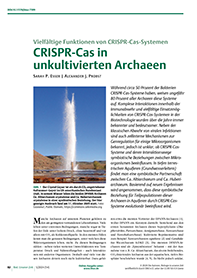The diverse functions of CRISPR-Cas systems in uncultivated Archaea
DOI:
https://doi.org/10.11576/biuz-7599Keywords:
DPANN-Archaeen, symbiotische Beziehungen, ImmunabwehrmechanismenAbstract
Small symbiotic archaea of the DPANN superphylum are some of the most mysterious organisms on earth. To better understand these mostly uncultivated organisms, the natural interaction of two such DPANN archaea – the free living DPANN archaeon Ca. Altiarchaeum and its episymbiont Ca. Huberiarchaeum – was described in a recent article entitled „A predicted CRISPR-mediated symbiosis between uncultivated archaea“, published in Nature Microbiology in 2023 [9]. In this study based on metagenomics and metatranscriptomics, the host Ca. Altiarchaeum encoding two different CRISPR-Cas systems and its episymbiont Ca. Huberiarchaeum were analysed in two different ecosystems. In both of them, the immune system of the host did not only target viruses but also the genome of the episymbiont. Assuming a direct cytoplasmic contact, metabolic modeling clearly demonstrated that the episymbiont cannot survive without its host and that the CRISPR-targeting can even be lethal. This kind of immune defense – based on CRISPRCas – could be identified bio-informatically in the genomes of other Archaea in aquatic ecosystems. All things considered, the analyses indicate that CRISPR-Cas systems and the way they function can be more complex than previously known. However, a direct proof in a laboratory by cultivating these organisms is still due because of a lack of suitable cultivation methods.

Downloads
Published
How to Cite
Issue
Section
License
Copyright (c) 2024 Sarah P. Esser, Alexander J. Probst

This work is licensed under a Creative Commons Attribution-ShareAlike 4.0 International License.

